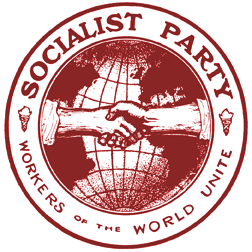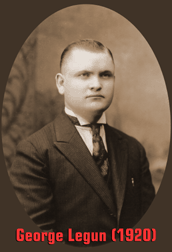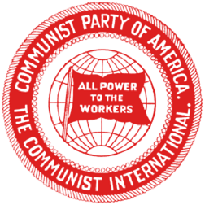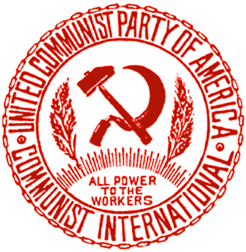UKRAINIAN LANGUAGE FEDERATIONS history
UKRAINIAN
FEDERATIONS
Ukrainian emigration to the United States began in a large scale in the late 1880s and peaked in 1914, when 67,000 people entered the US. The flow of emigrés declined sharply during the war years and though the trend reversed slightly in the early 1920s, the Immigration Act of 1924 essentially put an end to mass emigration from Ukraine to the United States. A mere 15-20,000 Ukrainian emigrés settled in America during the 1920s and 1930s.
[Source: Maria Woroby: “The Ukrainian Immigrant Left in the United States, 1880-1950”in Buhle and Georgakas (eds.): The Immigrant Left in the United States. (Albany: State University of New York Press, 1996), pg. 185.
The majority of Ukrainian emigrés to the United States during the heyday of American immigration were recruited from the impoverished peasantry. Agents from Pennsylvania coal mining companies and other earlier immigrants combined to attract poor Ukrainians to America. The typical Ukrainian emigré was an unmarried male between the ages of 14 and 44. Those women who made the journey were usually married. The Ukrainian immigrants to the United States found employment in anthracite (hard) coal mines, in iron and steel production, in the meat-processing industry, and in automobile production. They tended to settle in colonies in the industrial Northeast — Pennsylvania, New York, New Jersey — as well as in the industrial centers of the Upper Midwest, such as Ohio, Illinois, Minnesota, and Michigan.
[Source: Maria Woroby: “The Ukrainian Immigrant Left in the United States, 1880-1950,”pp. 185-186.
First Ukrainian Radicals in America — Haidamaky
The earliest Ukrainian-Ameican radicals were political emigrés who fled Tsarist Russia after the failure of the Revolution of 1905. These former members of the Ukrainian social democratic movement, including T. Pochynok and T. Lata, later played important roles in the formation of the Ukrainian Federation of the Socialist Party of America.
The first Ukrainian-American socialist organization established in the United States was Haidamaky, founded in 1907 in New York City. This group had a dual functions of athletics as well as education and began to publish a monthly publication in 1908. In 1909 the organization changed its name to the Ukrainian Progressive Workers’ Organization—Haidamaky and it made an initial approach to the Socialist Party to begin the process of formal affiliation. However the leadership of the organization decided to change the organization into a less political fraternal order in about 1911, prompting a split of the group’s left wing members to establish the Ukrainian Federation of the Socialist Party.
Haidamaky’s membership peaked in the subsequent years, attaining a membership of about 3,000 in 1916-17. The organization continued until the great flu epidemic of 1919 wiped out its assets, leving it bankrupt.
[Source: Maria Woroby: “The Ukrainian Immigrant Left in the United States, 1880-1950,”pp. 188-189.]
The Ukrainian Workers Party in America (URPA).
In 1909 or 1910, members of different American branches of the Ukrainian parent organization of Haidamaky met and adopted a platform calling for a new Ukrainian-American socialist organization. The new organization called itself Ukrainska Robitnych Partiia v Ameriytsi (The Ukrainian Workers Party in America). Affiliation with the Socialist Party of America was rejected due to the perceived tepid politics of the latter organization. The URPA adopted a newspaper published in Salem, Massachusetts called Khlopsky Paragraf (Peasant’s Paragraph) as its official organ.
The URPA was racked by internal squabbling over relations with the church and the Ukrainian national question and dissolved after about a year.
[Source: Maria Woroby: “The Ukrainian Immigrant Left in the United States, 1880-1950,”pg. 189.]
The Ukrainian Federation of the Socialist Party of America (UFSP).
The Ukrianian Federation of the Socialist Party of America (UFSP) had its roots in the Ukrainian-American radical press. In 1911 two Ukrainian emigrés from Germany, T. Pochynok and T. Lata, began publishing a newspaper called Proletar (Proletarian) in Detroit. The next year, a second Ukrainian radical paper called Robitnyk (The Worker) was established in Cleveland. The two Ukrainain socialist papers struggled for survival and supremacy.
In 1912, several Ukrainian branches of the Socialist Party were established, including branches in Detroit, Cleveland, Philadelphia, and New York City. Competition for control of the movement raged between Detroit and Cleveland — a bitter fight which tore apart the young Ukrainian socialist movement. By the end of 1913, only the Detroit branch of the SPA was active and both Proletar and Robitnyk had ceased publication.
By 1914 the Detroit organization had mattered to regroup and began publishing a new paper called Robitnyk. The emergence of this new publication energized the Ukrainian left, and local socialist branches were reorganized.
[Source: Maria Woroby: “The Ukrainian Immigrant Left in the United States, 1880-1950,”pp. 190.]
In 1915 the Ukrainian socialists of Detroit established a provisional committee with the task of organizing a formal Ukrainian Federation of the Socialist Party of America. This provisional committee included T. Pochynok, Fediusko, I. Hundiak, E. Kruk, Zavoiko, and Savruk.
About this same time, the Ukrainian immigrant socialists of Cleveland appointed a similar committee and began publishing their own paper, this time counterintuitively called Proletar. Another bitter split seemed to be in the offing, but the leadership of Haidamaky decided to intervene, brokering a deal which got the Detroit and Cleveland organizations to formally join forces and merge their competing newspapers. Cleveland was selected as the publishing site for the new Robitnyk because of superior printing plant and renewed efforts were made for formal alliance with the Socialist Party of America, which was granted in June 1915. At the time of its admittance, the Ukrainian Federation of the SPA had 20 locals and claimed a membership of 1,000.
[Source: Maria Woroby: “The Ukrainian Immigrant Left in the United States, 1880-1950,”pg. 191.]
1. First Convention of the UFSP — Cleveland, OH (?) — November 28-30, 1915.
The First Convention of the UFSP was attended by 12 delegates, representing 20 locals; 4 members of the UFSP’s Provisional Organizing Committee; representatives of Haidamaky; and two guests. C.E. Ruthenberg attended the convention as the representative of the SPA. The gathering was racked by disagreement over the position of the new socialist organization with the Ukrainain nationalist movemetnbeing established in New York in this period.
2. Second Convention of the UFSP — Rochester, NY — May 26-28, 1917.
Delegates to the 2nd Convention of the UFSP represented 46 locals with approximately 1,000 members. The “Internationalist”wing was in firm control of the gathering, which adopted the Socialist Party’s vigorous anti-militarist position on the European War. The Convention resolved that (1) as long as capitalistic rule exists, there will be slavery, imperialist exploitation, wars between nations, and class struggle; (2) Capitalism would only be destroyed through class warfare; and (3) Whoever follows a different path is not striving for true national freedom for the Ukrainian people, but are merely painting the yoke a different color while the form remains the same.
Evhen Kruk was elected Editor of Robitnyk. A new Executive Committee was elected, consisting of I. Bychk, A. Dmytryshyn, N. Kobrinskyi, N. Korzh, Evhen Kruk, D. Mois, and T. Pochynok.
Throughout 1917, support for the Russian Bolsheviki grew in the ranks of the UFSP. The leadership of the Federation, firmly internationalist, proclaimed alliance with the Bolshevik orientation and established close ties with the Bolshevik section of the Russian Federation of the SPA. This position gradually came into conflict with the editor of the Robitnyk, however, as Evhen Kruk supported a faction called the Ukrainian Social Democratic Labor Party and the establishment of a full-fledged independent republic in Ukraine. The increasing hostility between the Bolshevik and independent radical positions grew angrier and more bitter in 1918, prompting the UFSP Executive Committee to issue an open letter to the membership of the Federation in the May 9, 1918 issue of Robitnyk, announcing the forthcoming resolution of the problem at a special meeting of the UFSP council in Cleveland, May 13-15.
[Sources: Maria Woroby: “The Ukrainian Immigrant Left in the United States, 1880-1950,”pp. 194-195; Myron B. Kuropas: The Ukrainian Americans: Roots and Aspirations, 1884-1954. (Toronto: University of Toronto Press, 1991), pp. 169-173.]
At the May 13-15, 1918 plenum of the UFSP Executive Committee, editor Kruk was removed in favor of an editorial committee consisting of P. Ladan, George Legun [H. Lehun], D. Mois, and I. Selskyi.
On June 1, 1918, the Cleveland office of Robitnyk was raided by federal authorities and the staff members present were arrested. Among those jailed were M. Andreichuk, S. Korpan, P. Ladan, F. Pshybylskyi, V. Savchin, M. Turkevjch, and an innocent bystander who was watching the raid through a window. The UFSP’s Detroit offices were simultaneously raided, resulting in the arrest of George Tkatchuk, who was detained until the end of the war. Robitnyk resumed publication on June 10, 1918, with editorial material in that issue attempting to establish the anti-German position of the publication and the Ukrainian Socialist Federation. Several “social patriotic”members of the Detroit Ukrainian branch, including T. Pochynok, T. Lata, Y. Fediushko, and D. Borysko, called for a meeting of all Ukrainian socialists opposed to Bolshevism. The group called for disbanding the UFSP and establishing a new organization, but the group was unable to generate critical mass for its proposals and was subsequently expelled by the National Committee of the SPA.
[Source: Maria Woroby: “The Ukrainian Immigrant Left in the United States, 1880-1950,”pg. 196.]
In July 1918, the Cleveland office of Robitnyk was raided again and staff members arrested. P. Ladan, V. Savchyn, and I.S. Svitenkyi were unable to raise the nearly $15,000 required for bail and were jailed for months. A decision was made to abandon Cleveland in favor of New York City. While the newspaper’s printing equipment was in transit, a third police raid was launched. Authorities delayed the train carrying the Robitnyk press and archives outside of Cleveland for several days, destroying 19,000 archival documents of the publication and the Ukrainian Federation and intentionally damaging the press equipment. Robitnyk did not subsequently resume publication until Dec. 12, 1918.
Despite the efforts of the Wilson administration to shut down the Ukrainian Federation of the Socialist Party, the organization managed to log impressive membership growth. The UFSP expanded from nearly 2,000 members in 1917 to over 6,000 members in 1919.
[Source: Maria Woroby: “The Ukrainian Immigrant Left in the United States, 1880-1950,”pp. 196-197.]
3. Third Convention of the UFSP — (city ?) — April XX-XX, 1919.
At the 3rd Convention of the UFSP, the organization voted to formally recognize the Third International and to support the Left Wing Section of the Socialist Party in challenging the Center-Right coalition that held the SPA tightly in its grip.
In June of 1919, representatives of the UFSP met with other Socialist Party Language Federations to attempt to lay the groundwork for a Communist Party of America.
In its September 13, 1919 issue, Robitnyk proclaimed that as of September 1, 1919, “our Ukrainian Federation became...the Ukrainian Federation of the Communist Party of America.
[Source: Quoted in Maria Woroby: “The Ukrainian Immigrant Left in the United States, 1880-1950,”pg. 197.]
Ukrainian Federation of the Communist Party of America (UFCP)
In the fall of 1919 the Ukrainian Federation of the Socialist Party transformed itself into the Ukrainian Federation of the Communist Party (UFCP). There was little division within the organization between the two rival Communist Parties in the United States, with the Federation solidly backing the CPA over its rival, the Communist Labor Party. Only a small fraction, headed by Evhen Kruk, broke with the UFCP to join hands with the CLP. Kruk went on to edit a series of Ukrainian-language Communist publications, including Komunist (Communist, 1920), Nash Shliakh (Our Path, 1920), Chervona Zoria (Red Star, 1921), and Robitnycha Pravda (Workers’ Truth, 1922).
The official organ of the Ukrainian Communist Federation remained Robitnyk, published in New York. The paper was shut down as part of the Palmer Raids in January 1920 and dozens of memberws of the UFCP were arrested and jailed. With the rest of their organization, the members of the Ukrainian Federation of the Communist Party were driven underground. On January 31, 1920, Robitnyk was replaced by a new underground organ called Ukrainskyi Shchodennyi Visti (Ukrainian Daily News) — a publication which affiliated with the Ukrainian section of the International Workers Order (IWO) in 1932 and continued to publish into the 1940s.
[Source: Maria Woroby: “The Ukrainian Immigrant Left in the United States, 1880-1950,”pp. 199-200.]
Secretary of the Ukrainian Federation of the CPA in mid-1921 was “G. Padolisk."
In late 1921, during the 5 months between formation of the unified CPA and the split of the Central Caucus faction, the Communist Party’s Ukrainian Federation had an average monthly paid membership of 524, making it the 5th largest of the 10 Language groups in the party.
[Source: Comintern Archive: f. 515, op. 1, d. 75, l. 12.]
Ukrainian groups of the United Communist Party of America
There were only a dozen of the UCP’s 673 primary party units that spoke Ukrainian in December of 1920. These were located in just three districts — Cleveland (5), Chicago (4), and New York (3).
[fn: DoJ/BoI Investigative Files, NARA M-1085, reel 940, doc. 501 — downloadable below.]
Ukrainian Organizing Committee of the Socialist Labor Party of America
Although it never had a Ukrainian Language Federation, the Socialist Labor Party conducted agitation of the Ukrainian workerrs in America from approximately 1912. A monthly newspaper called Rabotnychy Holos [Workers’ Vocie] was published in Ukrainian, the publication based in Akron, Ohio, and printed at the plant of the South Slavonic Socialist Labor Federation. A number of pamphlets and leaflets were translated into Ukrainian and distributed, including works by Daniel DeLeon, Olive Johnson, and standard Marxist works such as the Communist Manifesto.
Editor of the Ukrainian organ Roman Zaremba found organization of the Ukrainians in America for the SLP difficult going in the aftermath of the revolution and civil war that swept the Ukraine, reporting to the 16th National Convention of the SLP in 1924:
“...among them reigns a great chaos, a chaos not to be found among other nations. They are divided and subdivided into so many groups that one almost loses all hope of getting them together. The leadership of that all but hopeless mass of workers is in the hands of very dishonest leaders, who exploit them to the utmost; the quarrels among the leaders are personal, namely, who has stolen more of the funds given by the dupes. Some of them picture the revolution in Ukraine as a real hell, and let loose all kinds of lies and insinuations against it in order that the Ukrainian workers in this country should not understand the call for help and should not understand the real situation; these are so-called nationalists. On the other side, we have our “burlesque bolsheviki”- a la “Workers Party”- who claim that Russian methods should be used in the United States. In fact they do not understand why they call themselves “Internationalists;”their activity is more of a section of the Communist Party of Ukraine and not of the United States."
[fn:R. Zaremba: “Report of the Ukrainian Organizing Committee,”in 16th National Convention, Socialist Labor Party, May 10-13, 1924: Minutes, Reports, Resolutions, Platform, Etc., pp. 92-94.]
Downloads
1919
APRIL
“Resolution Passed by the 3rd Congress of the Ukrainian Federation of the Socialist Party of America: New York, NY—April 1919.” This unanimous resolution of the April 1919 convention of the Ukrainian Federation of the Socialist Party proclaims that the Federation has “denounced in the past, we denounce now, and shall continue to denounce in the future, all groups and all parties which defend the old and corrupt social order.”Expressing pride in the Bolshevik revolution, the Federation insists “we unreservedly adhere to the Ukrainian (and international) Communist-Bolshevik Party. We shall continue to support it as the sole representative of revolutionary aspirations, as the only party competent to free the workers of all lands and all races from the heavy yoke of capitalism, as the only party which, upon the ruins of existing society, will be able to upbuild the new order, the resplendent and just order of Communism... We hold ourselves ready to fight in person as soon as we shall have overcome the obstacles put in our way by our powerful enemies.
All hail to the universal revolution!”
JUNE
“Scuttling the Ship: A Statement of the Seven Suspended Language Federations, June 2, 1919.” This is the joint protest statement of the 7 affected Language Federations of the SPA (Russian, Lithuanian, Ukrainian, Polish, Hungarian, South Slavic, and Latvian) in response to the May 27 action of the party’s National Executive Committee to unilaterally suspend the entire memberships of these organizations. The “autocratic 7”members of the National Executive Committee who approved this action on “over 30,000 dues payers”are rebuked for failing to provide notification, time for preparation, or a trial. In addition, the NEC bloc of 7 suspended the party elections and expelled the Michigan organization of nearly 6,000 without trial, locked up the party headquarters in the hands of a private holding company outside of party control, and arbitrarily threw the Translator-Secretaries of the affected federations out of party headquarters without allowing time for them to locate new quarters. “In short, this group of seven National Committeemen, drunk with power they assumed, feeling aggrieved because these federations dared to criticize the National Executive Committee, made themselves guilty of an act which will discredit them forever in the International Socialist movement,”the joint statement charged.
19120
DECEMBER
“United Communist Party — “Groups”According to Language: As of December 1920.” This is based upon an internal document of the United Communist Party captured by the Department of Justice’s Bureau of Investigation in the April 1921 raid on UCP National Headquarters in New York. The UCP prided itself on having largely eliminated the federation-based form of organization which typified its rival, the Communist Party of America. Groups (Primary Party Units of between 5 and 10 members) were nevertheless based around language as well as geography and statistics tabulated by the organization. This snapshot from the midpoint of the UCP’s one year of existence surprisingly shows more South Slavic (Croatian and Slovenian) language groups than any other (144), followed by the Russian (136), English (121), German (61), Latvian (49), Yiddish (37), Lithuanian (34), and Finnish (31) language groups.
1921
MAY
“CPA Condensed Cash Statement, Feb. to May 1921, Including Federations, But Not Including Payments to and from the National Office and the Federations: Presented to the Joint Unity Convention, Woodstock, NY - May 15, 1921.” This is a very esoteric budget document, but specialists in the history of the early American Communist movement will probably immediately recognize its import. For me, at least, this document has led to a fundamental rethinking about the nature of the old CPA, for it shows that the organization truly was a “federation of federations.”Five of the old CPA’s 6 Language Federations possessed assets at least twice the size of the National Office of the organization. The same 5 possessed printing plant in excess of the National Office. Three of them retained substantial real estate holdings. Three of them spent more money than the National Office on literature production, and a fourth spent approximately the same amount as the National Office. These were clearly fully functioning political organizations in their own right, not tiny social groups of members speaking a common language. It is little wonder that the “Federation Issue”stood so large on the landscape as the primary issue impeding merger efforts between the UCP and the old CPA for so long and fueling the Central Caucus split that erupted in late November of 1921.
1923
undetermined date
“Membership Series by Language Federation for the Workers Party of America. ‘Dues Actually Paid’ — January to December 1923.” Official 1923 data set of the Workers Party of America, compiled from a document in the Comintern Archive. This series shows a great numerical dominance of the WPA by its Finnish Federation, accounting for a massive 42.8% of the average monthly paid membership of the organization (6,583 of 15,395). The total of the English language branches is the 2nd strongest amongst the federations (7.6%) followed by the South Slavic (7.5%), Jewish [Yiddish language] (6.9%), and Lithuanian (6.0%) Federations. In all, there were statistics kept for 18 different language groups of the WPA in 1923, including the English and the barely organized Armenian sections.
“Initiation Stamps Sold by Federation for the Workers Party of America. January to December 1923.” Official 1923 data set of the Workers Party of America, compiled from a document in the Comintern Archive. This series once again (repeating the previous published 1924 series) shows a schizophrenic pattern of stamp sales among language groups . Some federations clearly did not collect the initiation fees called for in the WPA constitution at all (Jewish, German, Latvian) while at the same time the quantities sold via the English branches are ridiculously high. Over 53% of the initiation stamps sold for the entire WPA were credited to the English branches — nearly three times as many initiations than there were average duespayers in those English branches! Even assuming a significantly higher than average “membership churn”rate for English branches, there is clearly some other unexplained phenomenon at play in these English branch initiation stamp sale figures...
1924
undetermined date
“Membership Series by Language Federation for the Workers Party of America. ‘Dues Actually Paid’ — January to December 1924.” Official 1924 data set of the Workers Party of America, compiled from a document in the Comintern Archive. This shows a continued numerical dominance of the Workers Party of America by its Finnish-language federation, averaging a paid membership of 7100 (41% of the entire organization) for the year 1924. Impressive growth is shown by the Yiddish-language ("Jewish") federation, which moved to the third largest language group in the WPA in 1924. The English branches comprised the second largest language group in the WPA, but still remained just 11% of the overall organization. The South Slavic federation (predominately Slovenian and Croation) was the 4th largest language group in the WPA, topping the Russian, Lithuanian, and Ukrainian federations.
“Initiation Stamps Sold by Federation for the Workers Party of America. January to December 1924.” Official 1924 data set of the Workers Party of America, compiled from a document in the Comintern Archive. An extremely interesting monthly series in which two unexplained anomalies are apparent: (1) The failure of at least 8 of the WPA’s 18 language sections to make more than a token effort to collect the $1 initiation fee and obvious similar behavior (to lesser degree) among branches of other language groups; (2) A preposterously large sale of 5,264 initiation stamps to “English”branches, which averaged a paid membership of just 1909 over the course of the year. Either there was a revolving door in the English branches that was entirely dissimilar to the situation in any other language group of the WPA; or there was some sort of effort to collect initiation fees among “English”workers without organizational follow up; or there was some sort of strange accounting practice used by the WPA in which miscellaneous sales of initiation stamps were lumped into the “English”category (or some combination of these explanations). A perplexing question in raised, with further archival research clearly necessary.
MAY
“Report of the Ukrainian Organizing Committee of the Socialist Labor Party of America To the 16th National Convention of the SLP, May 1924” by Roman Zaremba. Despite the fact that it never had a Ukrainian Language Federation, the Socialist Labor Party did publish a monthly newspaper in Ukrainian as well as pamphlets and leaflets translated in Ukrainian. This report of the editor of Rabotnychy Holos [Labor Voice] to the 1924 SLP convention details the difficulty of organizing among the Ukrainian immigrant community — divided as it was between right wing nationalism on the other hand and various factions of the American Communist movement on the left.



